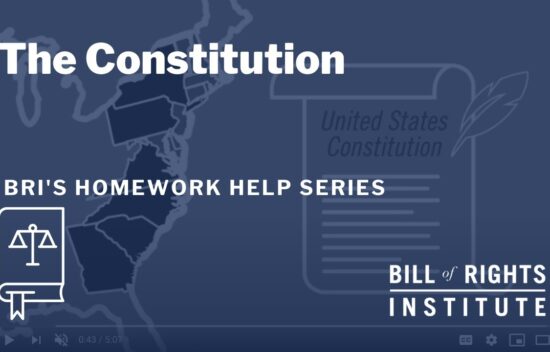
The United States Constitution
50 minWhat are the purposes of our national government?
Students will:
- Examine the purposes of the seven Articles of the Constitution.
- Understand the purposes for the national government set forth in the Preamble.
- Analyze how the structure of the US government is designed to protect individual liberties and freedom.
- Evaluate ways that the US government fulfills its purposes today.
- Handout A: Why Do We Have a National Government?
- Preamble [Appendix B]
- Handout C: Preamble Posters
- The United States Constitution [Appendix B]
- Handout B: Government Around the World (optional)
- Answer Key
- Ask students to share the responses they came up with on Handout A. See the Answer Key for suggested responses. Note: Students may suggest responses which are incorrect. Discuss these as a large group, explaining why the response does not work (i.e. it is a function of state or local government, individual responsibility, private enterprise, etc.) Keep a list of correct responses on the board or overhead.
- After listing about ten responses, ask students to fit the answers into general categories. Write the categories on the board or overhead.
- Distribute a copy of the Preamble [Appendix B] and discuss the following questions as a large group:
- Do the purposes listed match those of the Preamble?
- Does it matter whether the purposes of government are stated using simple words, or more formal, fancy ones?
- Have the purposes of government changed since the Constitution was written in 1787?
- If students have studied the Declaration of Independence, ask them to connect the aims of the Preamble with the conception of government contained within the Declaration.
- Before class, copy and put up Preamble Posters around the classroom. Under each Preamble Poster, tape a large sheet of paper.
- Divide the class into seven groups and have groups move from poster to poster. At each poster station, members of the group should write:
- One student should write in his or her own words what the phrase means.
- One student should write an example of the idea in action in America today.
- One student should write a non-example (the opposite) of the idea.
- Instruct groups to start writing at the bottom of the paper, and then fold and tape up the paper so that the next groups cannot see what they have written. After giving students time to visit all seven posters, have them return to their seats but remain their groups.
- Take down the papers with student responses from the Preamble Posters and give one to each group. Ask students to read aloud the rephrased ideas, and keep a list on the board. Then ask students to rank the seven purposes in order of personal importance with number one as the most significant, and number seven being the least significant.
- Discuss the following question as a large group: If the Preamble is the promise of what good government should be, how did the Framers of the Constitution make that promise a reality?
- Distribute the United States Constitution [Appendix B]. Briefly go over the purposes and content of the seven articles:
- Article I establishes the legislative branch and lists its powers, as well as powers denied to the Congress.
- Article II establishes the executive branch and lists the powers and duties of the president.
- Article III establishes the judicial branch and explains judicial power.
- Article IV describes the relationship among the states, and the federal government’s responsibility to guarantee each state a republican form of government.
- Article V describes the amendment process.
- Article VI explains that neither federal nor state laws can conflict with the Constitution and bans religious tests for office.
- Article VII dates the formation of the American people to 1776 and explains the ratification process.
- Ask students to read through the Constitution and locate examples of the government’s power to fulfill its purposes as spelled out the Preamble. See Answer Key for additional suggestions.
- Have students share their responses with the class.
- Ask students to write a one-page essay in which they answer the question: What fundamental beliefs about government are reflected in the United States Constitution? Examples could include limited government, consent of the governed, and representative government.
- Assign students one of the constitutional principles listed in Homework Option A, and draw an illustration that symbolizes the principle. Have them label their drawings. The next day, post illustrations around the room and give students time to view them all.
- Have students select another country to research and compare that nation’s constitutional structure to that of the United States. Students can report their findings on Handout B: Government Around the World.
- Have students create a collage of newspaper headlines, photographs, articles, and other artifacts which define or illustrate the purposes of government as established in the Constitution.




